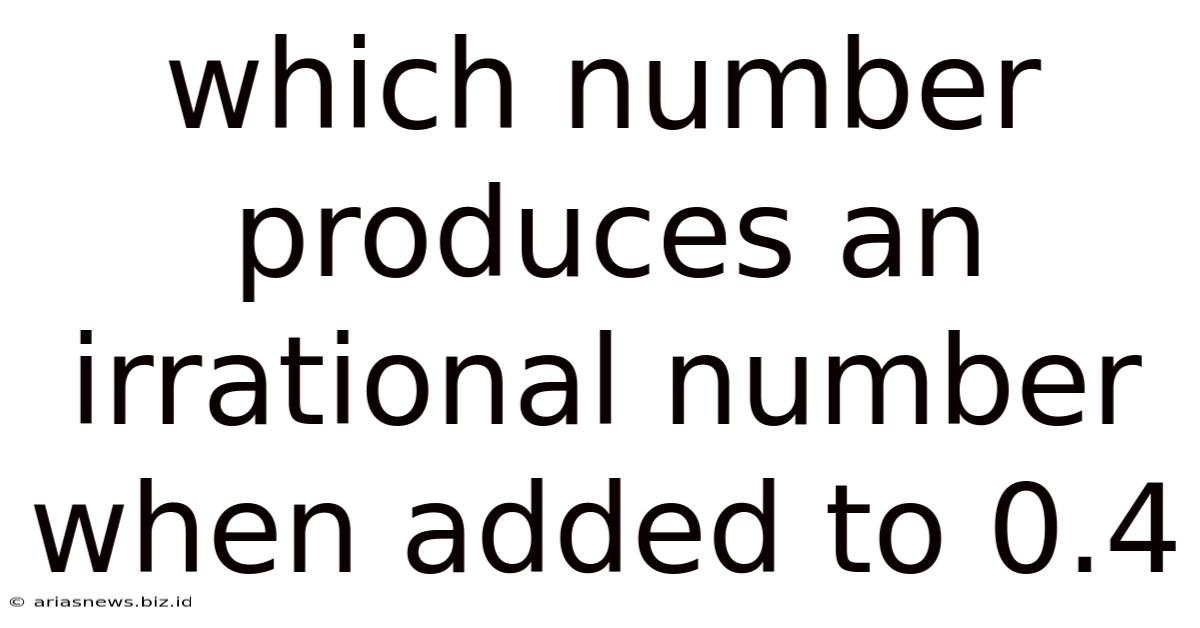Which Number Produces An Irrational Number When Added To 0.4
Arias News
May 10, 2025 · 4 min read

Table of Contents
Which Number Produces an Irrational Number When Added to 0.4? Exploring the Realm of Irrational Numbers
The question, "Which number produces an irrational number when added to 0.4?" might seem deceptively simple. However, it delves into the fascinating world of irrational numbers and their properties, demanding a deeper understanding of number systems. This article explores this question, dissecting the concept of irrationality, examining different types of numbers, and providing a comprehensive answer while highlighting the beauty and complexity of mathematics.
Understanding Rational and Irrational Numbers
Before we tackle the core question, let's establish a firm foundation. Numbers are broadly classified into two major categories: rational and irrational.
Rational Numbers: The Orderly Crowd
A rational number is any number that can be expressed as a fraction p/q, where p and q are integers, and q is not zero. This encompasses a wide range of numbers, including:
- Integers: Whole numbers (positive, negative, and zero). Examples: -3, 0, 5, 100.
- Fractions: Numbers expressed as ratios of integers. Examples: 1/2, 3/4, -2/5.
- Terminating Decimals: Decimals that end after a finite number of digits. Examples: 0.5, 0.75, 2.375.
- Repeating Decimals: Decimals with a pattern of digits that repeats infinitely. Examples: 0.333..., 0.142857142857..., 0.121212...
Irrational Numbers: The Unpredictable Mavericks
Irrational numbers, on the other hand, cannot be expressed as a simple fraction of two integers. Their decimal representations are non-terminating and non-repeating – they go on forever without ever settling into a predictable pattern. This seemingly chaotic nature is what makes them so intriguing. Famous examples include:
- π (Pi): The ratio of a circle's circumference to its diameter, approximately 3.14159...
- e (Euler's number): The base of the natural logarithm, approximately 2.71828...
- √2 (Square root of 2): The number which, when multiplied by itself, equals 2, approximately 1.41421...
- The Golden Ratio (φ): Approximately 1.61803..., found in nature and art.
The Crucial Addition: 0.4 + x = Irrational Number
Now, let's return to our original question: Which number (x) added to 0.4 results in an irrational number? The key lies in understanding that adding a rational number to an irrational number always produces an irrational number.
Let's prove this:
Assume we have an irrational number 'a' and a rational number 'b'. We can express 'b' as p/q, where p and q are integers and q ≠ 0. If a + b were rational, then it could also be expressed as r/s (where r and s are integers, and s ≠ 0).
Therefore, we would have: a + b = r/s
This implies: a = r/s - b = r/s - p/q = (rq - ps) / sq
Since r, s, p, and q are all integers, (rq - ps) and sq are also integers. This means that 'a' can be expressed as a fraction of two integers – contradicting our initial assumption that 'a' is irrational. Therefore, the sum of a rational and an irrational number must be irrational.
Finding the "x": A Multitude of Solutions
Since 0.4 is a rational number (it can be expressed as 4/10 or 2/5), adding any irrational number to it will yield an irrational result. This means there are infinitely many solutions for 'x'.
Examples include:
- x = π: 0.4 + π ≈ 3.54159... (irrational)
- x = √2: 0.4 + √2 ≈ 1.81421... (irrational)
- x = e: 0.4 + e ≈ 3.11828... (irrational)
- x = φ: 0.4 + φ ≈ 2.01803... (irrational)
- x = √3: 0.4 + √3 ≈ 1.96425... (irrational)
Beyond the Basics: Exploring Deeper Implications
This seemingly simple mathematical problem opens doors to a deeper understanding of number theory and its applications.
The Density of Irrational Numbers
The fact that infinitely many numbers satisfy the condition highlights the density of irrational numbers on the number line. Between any two rational numbers, there exists an infinite number of irrational numbers. This makes them far more prevalent than rational numbers, despite the seemingly easier representation of the latter.
Applications in Various Fields
Irrational numbers are crucial in various fields:
- Physics: Pi is fundamental in calculating the circumference, area, and volume of circles and spheres. Euler's number appears in numerous formulas related to exponential growth and decay.
- Engineering: Irrational numbers are essential in calculations involving curves, oscillations, and other phenomena.
- Computer Science: Algorithms dealing with geometric calculations and simulations often involve irrational numbers.
- Architecture & Art: The Golden Ratio has been used for centuries in creating aesthetically pleasing designs.
Conclusion: Embracing the Infinity of Irrational Numbers
The question of which number, when added to 0.4, produces an irrational number, reveals a fundamental truth about the nature of numbers. It’s not about finding a single answer, but rather recognizing the vast and infinite realm of irrational numbers and their crucial role in mathematics and various disciplines. Any irrational number will suffice, demonstrating the abundance and inherent density of these fascinating, unpredictable figures within the number system. This exploration underscores the beauty and complexity of mathematics, reminding us that even seemingly simple questions can lead to profound insights into the intricate structure of our numerical world.
Latest Posts
Latest Posts
-
Is There 16 Oz In A Pound
May 10, 2025
-
Who Was With Mary When Jesus Was Crucified
May 10, 2025
-
Type The Number 1340000 In Scientific Notation
May 10, 2025
-
When Will Easter Fall On April 2nd
May 10, 2025
-
How Many Fl Oz Are In A Bottle Of Water
May 10, 2025
Related Post
Thank you for visiting our website which covers about Which Number Produces An Irrational Number When Added To 0.4 . We hope the information provided has been useful to you. Feel free to contact us if you have any questions or need further assistance. See you next time and don't miss to bookmark.